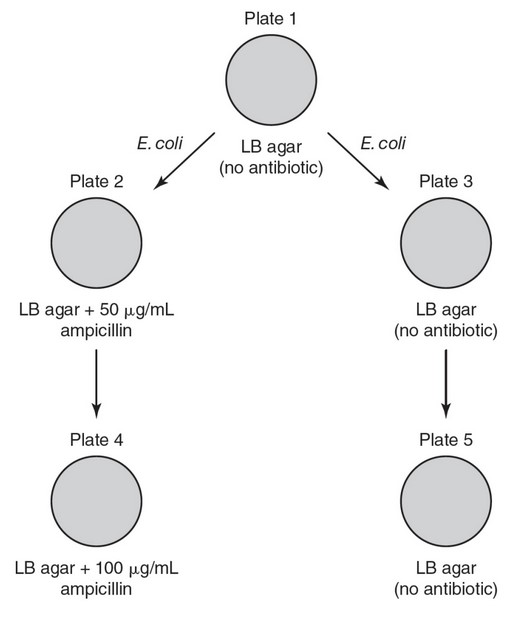Question
A student performs an experiment to study the effects of repeated exposure to antibiotics on bacteria. A strain of E. coli that is not
antibiotic resistant is grown on an antibiotic-free LB agar plate (plate 1), the starter plate. Some of the E. coli from the starter plate are then
spread on a plate that contains LB agar and 50 ug/mL of the antibiotic ampicillin (plate 2), and some of the E. coli are spread on a plate that
contains LB agar without antibiotic (plate 3). E. coli from plate 2 are then spread on a plate that contains LB agar and 100 ug/mL of the
antibiotic ampicillin (plate 4). E. coli from plate 3 are then spread on a plate that contains LB agar without antibiotic (plate 5). A diagram of
the experimental plates is shown in the figure.
(a) Describe whether E. coli that are all susceptible to ampicillin, all
resistant to ampicillin, or a mix of both will grow on the starter
plate. Explain your answer using the principles of natural
selection.
(b) Identify the plates that serve as controls in this experiment.
Identify the independent variable in the experiment.
(c) Predict the relative amount of E. coli growth on plates 2, 3, 4, and
5.
(d) Justify your prediction from part (c).
▶️Answer/Explanation
Ans:
(a) It is likely that the E. coli on the starter plate (plate 1) contain
mostly bacteria that are susceptible to ampicillin and some bacteria
that are resistant to ampicillin. Natural selection acts upon
variations in populations, and it is likely that there are varying
degrees of resistance to ampicillin in the bacteria population.
(b) The controls are plates 3 and 5 (the plates without ampicillin). The
independent variable is the concentration of ampicillin on each
plate.
(c) Plates 3 and 5 will have many bacteria, perhaps a solid “lawn” of
bacteria on each of those plates. Plates 2 and 4 will have very few
bacteria growing on them.
(d) Since the starter plate did not contain ampicillin, there was no
selection for ampicillin resistance on that plate, and so the majority
of the bacteria on the starter plate are expected to not have
resistance to ampicillin. Therefore, very few bacteria are expected
to grow on plates 2 and 4, which contain ampicillin. Many more
bacteria will grow on plates 3 and 5 since those plates do not
contain ampicillin.
Question
Can natural selection perfect a species? Explain. Support your choice with examples from nature.
▶️Answer/Explanation
Ans:
Natural selection is unlikely to create a perfect species (and the
definition of perfect is not universally agreed upon). If ever “a perfect
species” could exist, it would be “perfectly adapted” to its environment. But
environments are always changing, slowly or quickly. And so, natural
selection is unlikely to create a perfect species.
The two greatest limitations are (1) lack of planning and (2) structural
limitations.
(1) Lack of planning: A population must seed its next generation to
be present in the future. Whatever phenotype is “good enough” to
survive long enough to reproduce gets some of its genes represented
one more time, in the next generation. Natural selection acts only
on the gene pool that is present. There appears to be no short-
term planning (the next generation) or long-term planning
(several generations down the line). Selection favors what works
right now to continue this lineage for one more generation. To
continue to exist, this process must continue to be repeated.
However, nothing is guaranteed. Finally, random factors can have a
great impact on what survives, regardless of how well adapted they
may be. For example, the K/T mass extinction was caused (at least
much in part) by a meteor strike and massive volcanism.
(2) Structural limitations: Features of organisms almost always
evolve from the pre-existing features of their ancestors. Although
mutation and genetic rearrangement have clearly produced “new”
alleles and structures throughout time, these processes have
generally done so by the modification of pre-existing structures.
For example, nails, hair, talons, skin, and scales (of bony fish) are
all made of the same protein, keratin. No known organisms have
structures made of titanium: There’s simply no genetic program or
biological mechanisms to build it. Organisms are also limited by
their ability to accumulate and manipulate certain materials.
Without transporters to allow the specific uptake of titanium from
the environment or the cells that could build structures with it, there
is no way to exploit an environment in which it is available. Think of all the nitrogen in the atmosphere that for billions of years only
bacteria could “fix” into forms usable by other life-forms. (Fritz
Haber figured out the process in a laboratory in 1909.)
Question
Introducing errors occurs 100,000 times more often in the combined processes of RNA synthesis and protein synthesis compared with
DNA synthesis.
(A) Explain why this does not have a greater effect on phenotype (compared to a similar error in DNA).
(B) Explain why selection did not act as strongly for high-fidelity
mechanisms of transcription and translation.
▶️Answer/Explanation
Ans:
RNA is continually synthesized from a DNA template and degraded.
Many copies of the RNA molecule for a particular gene are transcribed when gene expression is activated, but they are all copied directly from the DNA and not from other RNA molecules. Out of many RNA molecules, only one
or a few will likely contain the mutation. Mistakes in a few RNA molecules
are probably not significant to have an effect if not passed on to daughter
cells, and the effect is likely transient since those RNA molecules are
degraded and new ones are synthesized from the DNA template.
The DNA is the template for all RNA molecules. If the nucleotide
sequence in a protein-coding region has a mutation, every RNA transcribed
from that DNA sequence will have the complementary mutation. The DNA is
not typically degraded, particularly in dividing cells. All progeny cells would
receive the mutated sequence, an incorrect copy of the gene.
